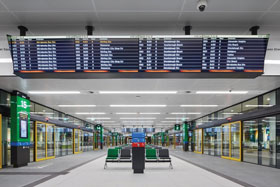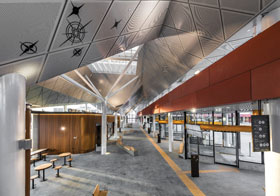People may need to transfer to another transport mode or route at some point during their journey. To do this, they exit the service, navigate their way through an interchange or other environment to the next service, and then board. Changing services or modes occurs at an interchange. Some of these transfers occur in a purpose built interchange, while others require travellers to exit one service/form of public transport and travel to their next stop or station, usually by the urban street network. Transfers need to be efficient as delays may cause customers to miss their next service, or a specific accessible service, impacting their confidence and level of stress.
People with disability have highlighted that they are less likely to embark on public transport journeys that involve interchanges as it adds complexity and uncertainty to their trip.
Aspirations for this journey part
- People are not deterred from a public transport journey because it involves an interchange.
- The interchange experience is as easy, convenient and efficient for a person with disability as it is for other public transport users.
How can we achieve this?
3.5.1 Coordination of different operators
Interchanges are places where different services and modes, sometimes managed by different operators, converge to provide journey options for people. Public transport providers should strive to coordinate services as much as possible to provide a seamless experience for travellers, which will also encourage greater use. For example, wait times between services delivered by different operators should be considered and optimised for customers.
A ‘precinct’ approach should be taken in complex interchange environments, such as airports and major rail or bus stations, where all providers come together to discuss interchange interfaces and find ways to improve these for their customers. Airports are particularly challenging for people with disability for a range of reasons, including their large size, security requirements and difficulty navigating from drop-off points to check-in counters.
3.5.2 Wayfinding
Wayfinding is important to enable people to exit a transport service, quickly orientate themselves and locate the boarding point for their next service or the exit.
Wayfinding takes into account all the cues people use to orientate themselves within an environment. This includes looking for known landmarks, knowledge from previous experiences at that (or a similar) location, indicators such as signage or tactile ground surface indicators (TGSIs), maps, apps, sounds, textures, contrasts, temperature, interaction with other people (including customer service staff) and other cues.
People with disability may rely heavily on some of these cues and find others to be of no use. For example, a person who is blind or has low vision may find they rely heavily on sounds, texture, temperature and TGSIs to navigate their way.
Transport interchange design should consider wayfinding from the start and use its principles to deliver an environment that users can intuitively navigate. Standardised designs for interchanges could further facilitate navigation.
In addition to great design outcomes, wayfinding strategies and plans should be considered, especially in complex, busy interchange environments. These designs and plans should consider multiple wayfinding options to cater for people's varied information needs. People with disability should be involved in creating wayfinding strategies and plans. For example, for a person with cognitive impairment, pictorial representations as well as signs will be beneficial. These will also help those whose first language is not English.
A small (100 square metres) easy to access communications centre in large transport interchanges such as airports could facilitate access to information. This could include for example a range of communication and accessibility features such as Braille, audio loops, sound and lighting with ‘changing places’ premium toilets nearby40.
3.5.3 Boarding points
Lead stop operations—where multiple services stop in order of arrival rather than having a dedicated stop per service/destination—have been highlighted by people with disability as problematic when it comes to service recognition, moving to the right location on the platform and hailing the driver.
Dynamic stand allocation is a new approach to bus management that is being implemented around the world. It uses real-time information to assign buses to vacant stops based on their route and arrival or departure time. While this approach significantly reduces the space required for the interchange, people's ability to move to the required bus stand also needs to be taken into consideration. Appropriate information also needs to be provided—and time allowed—for them to complete this movement. The business case for new approaches such as these must include consideration of accessibility implications.
Examples include the use of auditory, visual and touch-based advisory systems to communicate stand locations. Approaching vehicles should also display information to help travellers navigate between stands and boarding points, and customer service staff, such as a concierge, should also be available. These initiatives need to be underpinned by clear and consistent stand allocation protocols and underscored by passengers having sufficient information and time to access their transport.
As with any new system or approach, a review of the user and operator experience and what has and hasn"t worked is important to inform improvements and other developments.
3.5.4 Vertical transportation
Moving between floors within an interchange can be one of the most difficult aspects of the travel experience. People with accessibility requirements, especially those who rely on mobility devices, have highlighted that there are usually limited opportunities to travel between floors/levels.
Pre-journey planning needs to be supported by tools that identify where lifts, escalators, ramps and assistance are available. This should also consider the need for a different route or use of an alternative entrance/exit at an interchange.
Considering the potential impact of disruptions in the middle of a journey is also important, for example, a broken lift can be a major impediment. Contingency information in pre-journey planning tools and real time communications within a facility should also be provided. This should include alternate or additional facilities such as second lifts, ramps or direct assistance.
3.5.5 Platform/stop changes
People with disability have highlighted that late platform or stop changes within an interchange present a significant challenge to them. If a change must be made, this should be announced by both audible and visual means. Consideration also needs to be given to minimising the distance that people need to move to access a new boarding point, and avoiding changes that require vertical transportation to access the new location.
3.5.6 Kiss and ride and taxi facilities
The convenient access to an interchange for people with disability is often from where they are set-down at dedicated drop-off/pick-up zones. These should be located and designed to provide clear and legible access to major interchange entry points and visible when exiting.
3.5.7 Real time information
Information about service arrival and departure times and locations should be provided visually and by audible announcements within the interchange.
Alerts, particularly in relation to safety matters, need to be provided in formats that ensure all users receive necessary information. For example, a person with a significant hearing impairment will need a visual alert, as standard audio alerts will not work41.
3.5.8 Acoustic environment
Interchanges are often noisy, especially during peak travel times. Speaker quality and building acoustics should be tested to ensure audio announcements are high quality.
Announcements should be spoken slowly and clearly to aid understanding. Feedback from people who are hard of hearing is that accents, high pitched voices and quiet voices can all impact their ability to understand announcements.
Audible advertising can also impact people's ability to hear announcements, so limiting this is preferable. This is also discussed at section 3.5.3 (boarding points).
3.5.9 Supporting infrastructure
While some people try to reduce the amount of time they need to spend at an interchange, others may use interchanges as a place to break their journey, access amenities and rest before continuing.
Supporting infrastructure such as accessible bathroom facilities and seating should continue to be considered under the appropriate standards.
As the concept of workplaces become more fluid, infrastructure such as Wi-Fi and mobility aid charging points could be considered to enable time spent at interchanges to be productive. All such services should be identified visually and audibly, and referenced in journey planning materials.
3.5.10 Customer service staff uniforms
People with disability have highlighted that the symbology and colour of customer service staff uniforms is very important to them when they are in a busy interchange. Being able to easily identify service staff is critical to the accessibility of their journey. When uniform changes are proposed, this should be taken into consideration.
| Dynamic stand allocation at Perth's Wellington Street Bus Station The Public Transport Authority of Western Australia recently opened Australia's first bus station using dynamic stand allocation. The station has a consolidated passenger waiting lounge, similar to an airport waiting lounge, with passengers boarding buses through sliding glass doors. This follows international developments in bus station design and provides quiet air-conditioned waiting areas, high quality seating and furnishings, and real-time information on 116 screens throughout the station. Accessibility was considered during the new bus station's design and development by adopting a semi-dynamic arrangement. Bus route groups are permanently assigned to groups of stops so that passengers will always wait in the same area. Individual bus arrivals are dynamically assigned to stops within that group. |
 Figure 13—New waiting lounge at Wellington Street Bus Station, Perth, © Public Transport Authority of Western Australia |
| Christchurch bus interchange The planning and design of Christchurch's new bus interchange included input from groups including the city's Disability Advisory Group and an audit by the national Barrier Free New Zealand Trust. Early and regular consultation with disability groups resulted in positive accessibility outcomes for all users. For example, the interchange features walking strips and electronic Braille information stands for people who are blind or have low vision, and step-free ground-level access and signage heights and types designed with all users in mind. This bus interchange also uses dynamic stop allocation. |
 Figure 14—Consultation with disability groups helped achieve positive accessibility outcomes for all users © Otakaro Limited |
40 Deaf Blind Association on the draft guide.
41 Vision Australia submission on the draft guide.